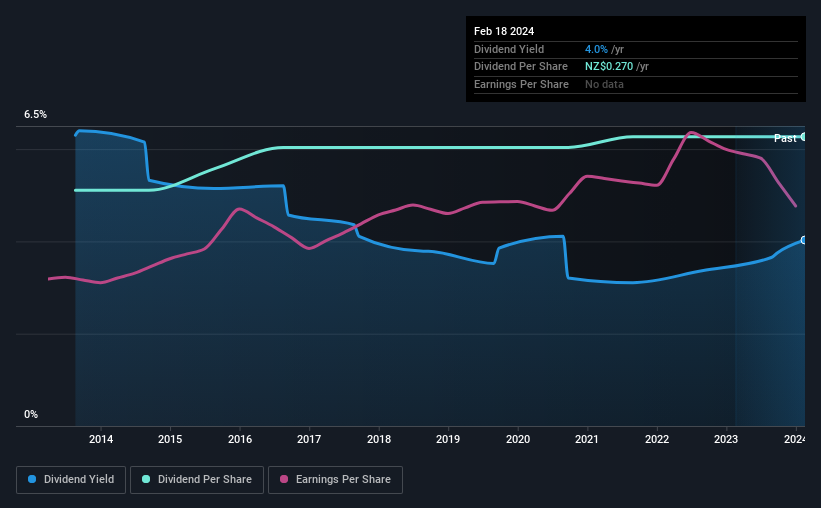The board of South Port New Zealand Limited (NZSE:SPN) has announced that it will pay a dividend of NZ$0.0882 per share on the 12th of March. Based on this payment, the dividend yield on the company's stock will be 4.0%, which is an attractive boost to shareholder returns.
View our latest analysis for South Port New Zealand
South Port New Zealand's Dividend Is Well Covered By Earnings
We like to see robust dividend yields, but that doesn't matter if the payment isn't sustainable. Before making this announcement, South Port New Zealand was earning enough to cover the dividend, but it wasn't generating any free cash flows. In general, we consider cash flow to be more important than earnings, so we would be cautious about relying on the sustainability of this dividend.
Over the next year, EPS could expand by 0.6% if the company continues along the path it has been on recently. Assuming the dividend continues along recent trends, our estimates say the payout ratio could reach 88%, which is definitely on the higher side, but we wouldn't necessarily say this is unsustainable.

South Port New Zealand Has A Solid Track Record
Even over a long history of paying dividends, the company's distributions have been remarkably stable. Since 2014, the annual payment back then was NZ$0.22, compared to the most recent full-year payment of NZ$0.27. This implies that the company grew its distributions at a yearly rate of about 2.1% over that duration. Slow and steady dividend growth might not sound that exciting, but dividends have been stable for ten years, which we think makes this a fairly attractive offer.
South Port New Zealand May Find It Hard To Grow The Dividend
Investors could be attracted to the stock based on the quality of its payment history. However, South Port New Zealand's EPS was effectively flat over the past five years, which could stop the company from paying more every year. Growth of 0.6% per annum is not particularly high, which might explain why the company is paying out a higher proportion of earnings. This isn't bad in itself, but unless earnings growth pick up we wouldn't expect dividends to grow either.
In Summary
In summary, while it's good to see that the dividend hasn't been cut, we are a bit cautious about South Port New Zealand's payments, as there could be some issues with sustaining them into the future. While the low payout ratio is a redeeming feature, this is offset by the minimal cash to cover the payments. We would be a touch cautious of relying on this stock primarily for the dividend income.
Market movements attest to how highly valued a consistent dividend policy is compared to one which is more unpredictable. However, there are other things to consider for investors when analysing stock performance. For example, we've picked out 2 warning signs for South Port New Zealand that investors should know about before committing capital to this stock. Looking for more high-yielding dividend ideas? Try our collection of strong dividend payers.
New: Manage All Your Stock Portfolios in One Place
We've created the ultimate portfolio companion for stock investors, and it's free.
• Connect an unlimited number of Portfolios and see your total in one currency
• Be alerted to new Warning Signs or Risks via email or mobile
• Track the Fair Value of your stocks
Have feedback on this article? Concerned about the content? Get in touch with us directly. Alternatively, email editorial-team (at) simplywallst.com.
This article by Simply Wall St is general in nature. We provide commentary based on historical data and analyst forecasts only using an unbiased methodology and our articles are not intended to be financial advice. It does not constitute a recommendation to buy or sell any stock, and does not take account of your objectives, or your financial situation. We aim to bring you long-term focused analysis driven by fundamental data. Note that our analysis may not factor in the latest price-sensitive company announcements or qualitative material. Simply Wall St has no position in any stocks mentioned.
About NZSE:SPN
Solid track record established dividend payer.
Market Insights
Community Narratives



